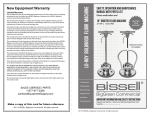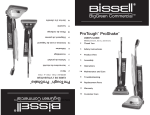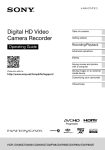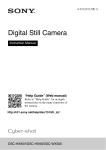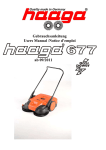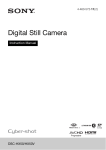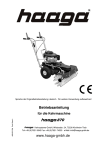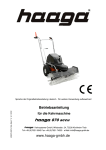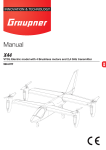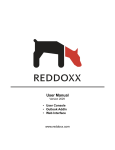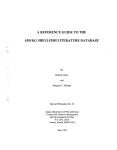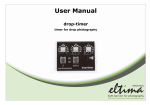Download User Manual
Transcript
JanitorialEquipmentSupply.com 1-877-977-3339 haaga 475 / 477 / 497 • Operating instructions Publisher's notice Dear customer, thank you for purchasing a quality product from Haaga. This product has been manufactured using modern production processes with comprehensive quality assurance measures. These instructions will allow you to use the sweeper safely and efficiently. Before using the sweeper for the first time, please carefully read the "Safety instructions" chapter. If you have any questions about your sweeper, please ask your specialist dealer or contact us directly at: These instructions form part of the sweeper and must be kept in the vicinity of the sweeper at all times for reference by the user. These instructions must remain with the sweeper if the machine is lent out or sold. Haaga Kehrsysteme GmbH Wielandstr. 24 D-73230 Kirchheim / Teck Tel. +49 (0) 70 21 36 42 Fax. +49 (0) 70 21 7 43 25 [email protected] www.haaga-gmbh.de Illustrations in these instructions are provided for the purpose of general understanding and may differ from the actual sweeper version. Model designation: haaga 475 haaga 477 / iSweep haaga 497 / iSweep Revision history Version 1.0: February 2015, Creation Copyright © 2015 Haaga Kehrsysteme GmbH All rights reserved 22 English 1 About these instructions 1.1 Symbols used Warning! A warning informs you about possible health risks or risks of fatal injury to yourself and other persons that may occur when handling or using the sweeper. CAUTION! Indicates a possibly dangerous situation. This can lead to damage to property or the environment if not prevented. NOTE Highlights useful tips and recommendations as well as information for efficient and trouble-free operation. 1.2 Technical further development We are continuously working on further development of all our products. We therefore reserve the right to make changes in the scope of delivery with respect to form, technology and equipment. No claims can therefore be derived from information and illustrations contained in these instructions. 1.3 Warranty • The relevant national regulations apply in each country. Excepted from this are wearing parts such as sweeping lip, angled wheels and running wheels. • Please enclose a copy of the invoice in the event of a warranty claim. • Only genuine Haaga spare parts must be used. • No technical modifications must be carried out on the sweeper. • All claims under guarantee and warranty will be rendered void if the machine is not operated properly. 1.4 Target group These instructions are intended for the person using this sweeper. Prerequisites • Persons who operate the sweeper must be informed about the dangers related to use of the machine. • Persons who operate the sweeper must be rested, healthy and in good physical condition. • Only pass on or loan the sweeper to persons who are familiar with this model and its handling – always provide the instructions with the machine. • Persons who are using the sweeper for the first time must have safe operation of the machine explained to them by the salesperson or another qualified person before they operate the sweeper. • Children should be supervised to ensure that they do not play with the sweeper. 23 • Minors must not operate the sweeper – except for juveniles over the age of 16 who are trained under supervision. • This sweeper is not intended for use by persons (including children) with restricted physical, sensor or mental capacity or persons who lack experience and/or knowledge, unless they are supervised by a person responsible for their safety or received instructions from this person on how to use the machine. • Persons who are prohibited from strenuous physical activity for health reasons should ask a doctor for advice on whether working with the sweeper is possible. • The sweeper must not be operated after consumption of alcohol, medicines that impair reaction times or drugs. 2 Safety instructions Safety instructions prevent danger to life and limb and also avoid damage to property or the environment due to improper use of the sweeper. The sweeper is intended for commercial use, e.g. in hotels, schools, hospitals, factories, shops, offices and the equipment hire trade. For this reason, you must read these instructions carefully and follow the safety instructions contained in them before using and working on the sweeper. The sweeper is intended exclusively for removal of road dirt, leaves, grass, paper and similar debris. The user of the sweeper is responsible for injuries and damage that are caused due to non-compliance with these instructions. 2.1 Intended use This sweeper is designed in accordance with the state of the art and recognised safety regulations. Nevertheless, use of the sweeper can lead to dangers for the user or third parties or damage to the sweeper and other material assets. 24 Sweeping snow with the sweeper is not permitted. Any other use will be deemed as improper use. The manufacturer will not be liable for damage caused as a result of this. The user is solely liable for the associated risks. Claims of any kind due to damage caused by improper use are excluded. The following information must also be observed when operating the sweeper: • the safety instructions in these operating instructions. • Always wear a dust protection mask in dusty conditions. • compliance with the operating, maintenance and storage conditions prescribed by the manufacturer. • Wear sturdy gloves. • compliance with accident prevention regulations as well as country-specific safety regulations, e.g. as issued by employers' professional liability associations, social security authorities, occupational health and safety bodies and others. • national and local regulations on time restrictions for operation of noise-emitting equipment. The sweeper must not be used, for example, for sweeping substances that are hazardous to health, flammable or glowing (e.g. cigarettes, matches), liquids, explosive or hazardous dusts (Ex), acids or solvents. The sweeper must not be used in explosion-hazard areas or as a means of transport. 2.2 Safety instructions for operation / Maintaining operating safety The user must not wear open long hair, tie, loose clothing or jewellery, including rings. Use the machine only in technically perfect condition for its intended purpose and paying attention to safety and the environment. Have any faults that affect safety rectified immediately by a specialist dealer. Observe all safety and danger instructions on the sweeper. The user must ensure the presence and legibility of all warning and information notices throughout the entire service life of the sweeper. Use only genuine spare parts and accessories that have been approved by the manufacturer. These guarantee that the machine can be operated safely and without faults. Do not carry out any modifications, attachments or conversions on the sweeper that could impair safety without the approval of the manufacturer! The manufacturer excludes all liability for injuries or material damage caused by use of attachments that have not been approved. There is a risk of injury, e.g. getting caught up or pulled into the machine. The maintenance work described in these instructions must be carried out completely and at the specified intervals either by the user or at a specialist dealer. Use personal protective equipment if necessary or required by regulations! 2.3 Instructions for transport • Wear sturdy shoes with a high-grip, anti-slip sole. NOTE • Do not carry the sweeper by the handle of the waste bin. 25 English • the chapter "Technical data" in these instructions. • In vehicles: Secure the sweeper to prevent it from tipping, slipping or being damaged. 2.4 Instructions for work preparation Danger of injury • The sweeper must be operated only in operationally safe condition. • Put the sweeper into operation only if all the components are undamaged. • Check the sweeper to ensure that it is in operationally safe condition – observe the corresponding chapters in the instructions. 2.5 Instructions for operation Danger of fire! • Do not sweep up any burning or glowing items, e.g. cigarettes, ash or matches. Risk of accident! • Use the sweeper only for its intended purpose. • Do not climb on the sweeper or use it as a means of transport. • Do not operate the sweeper without fitted waste bin. • Never reach into the rotating brushes. • Never reach into the running sweeper. • When operating the sweeper, take into account the local conditions and pay attention to other persons, particu- 26 larly children, when working with the machine. • Take care in slippery, wet or snowy conditions. There is a risk of slipping on slopes or uneven ground. • Make sure that the sweeper does not collide with objects, e.g. shelves, scaffolding during operation – danger due to objects tipping over or falling down. • Take breaks in good time in order to avoid fatigue and exhaustion. • In the event of a blocked disc brush or blocked fine dirt sweeping roller, interrupt work and clear the blockage. Wear sturdy gloves in order to avoid cut injuries due to sharp objects. • If the sweeper has been subject to loads other than those that occur during normal use (e.g. forces caused by impacts or falling), always check to ensure that it is still in operationally safe condition before continuing work – also see "Instructions for work preparation". Pay attention in particular to correct functioning of the safety devices. • Do not continue to use machines that are no longer operationally safe. Consult a specialist dealer in case of doubt. Danger of explosion! Sparks can ignite dust or vapours in explosion-hazard areas and cause explosions. • Never operate the sweeper in areas where there is an explosion hazard. JanitorialEquipmentSupply.com 1-877-977-3339 Danger of injury! • The sweeper is designed for operation by one person only – do not allow any other persons into the working area. • Pushing against or over obstacles, e.g. kerbs, can lead to damage to the sweeper. • If the cleaning performance deteriorates, check whether the waste bin is full or if the disc brushes or fine dirt sweeping roller are blocked or worn. • Keep children, animals and spectators away from the sweeper. 2.6 Information on fill level in waste bin • The user is responsible for accidents or risks that occur with respect to other persons or their property. NOTE CAUTION! Damage to the sweeper due to improper use. • In the case of noticeable changes in running behaviour (e.g. higher vibrations, sluggish movement), interrupt work and rectify the causes of the changed behaviour. • Do not leave the sweeper in the rain. NOTE • When sweeping up leaves, improve the capacity of the waste bin by briefly placing the sweeper on the rear side of the waste bin. • Guide the push handle with both hands. • Push the sweeper forwards and adapt the speed to the conditions. • The sweeper can be pushed over small bumps with a height of 2–3 cm by pushing down slightly on the push handle. English • Never operate the sweeper in the vicinity of combustible fluids (vapours), gases or dust. • The waste bin is full if dirt is pushed in front of the machine and no dirt is swept up. • In order to continue working for a short time, lift the sweeper at the front to move the dirt to the rear of the waste bin. This makes it possible to make better use of the waste bin capacity. 2.7 Instructions for cleaning NOTE • Cleaning ensures proper functioning and a long service life for your sweeper. • Accumulated dirt deposits and wound-up threads etc. behind the roller mounting can lead to sluggish operation of the sweeper and impair functioning. Danger of injury! • Wear sturdy gloves in order to avoid cut injuries, e.g. due to glass shards, metal or other sharp-edged materials. 27 CAUTION! Damage to the sweeper due to improper cleaning. • Do not use grease removers for cleaning. • Do not use aggressive detergents. • Do not clean with compressed air. • Do not spray-clean with water or immerse in water. • Clean plastic parts with a damp cloth. 2.8 Instructions at the end of work NOTE • Empty the waste bin each time after use. Health risk! • Empty the waste bin outdoors if possible in order to avoid production of dust. 2.9 Instructions for storage Risk of accident! • Do not reach into the swivel area of the push handle – parts of the body may be trapped between the push handle and housing if the push handle falls over unintentionally. • When storing the sweeper, position it so that no persons are endangered. • Secure the sweeper to prevent unauthorised access. 28 • Secure the sweeper to prevent it from falling over and so that the push handle cannot fold down in an uncontrolled manner. NOTE • Store the sweeper securely in a dry room. 2.10 Instructions for maintenance and repair NOTE • Carry out maintenance of the sweeper regularly. Perform only the maintenance work described in the instructions. • Have repairs carried out only by the manufacturer's authorised dealers. CAUTION! Damage to the sweeper due to improper maintenance. • Repairs must be performed only by authorised service centres or by specialists in this field who are familiar with all relevant safety regulations. 2.11 Instructions for disposal CAUTION! • Incorrect handling of environmentally hazardous materials, particularly incorrect disposal of replacement parts, can cause considerable damage to the environment. English 3 Design and function Important components 1. 2. 3. 4. 5. 6. 7. 8. 9. 10. 11. 12. 13. 14. 15. 16. 17. 18. 19. Push handle Waste bin Waste bin handle Disc brush height adjustment Carrying handle Disc brush Side guide roller (not 475) Running wheel Fine dirt sweeping roller Holding-down device (not 475) Dust filter (not 475) 10 Machine number (477/497) Machine number (475) 7 Angled wheel Sweeping lip Sweeping plate Clutch Toothed sleeve Gear protection (not 475) 14 17 1 3 13 4 8 5 6 6 14 12 15 13 18 19 2 11 16 9 9 29 4 Putting into operation Fitting the push handle: 475 Danger of injury! Danger of injury! • Avoid injury due to push handle accidentally falling over. 1. Engage handle fittings (1) in frame by knocking gently. 2. Turn handle fittings (1) so that they are positioned vertically upwards. 3. Press locking springs (3) on push handle (2). 4. Push the push handle (2) simultaneously into the two handle fittings (1). 5. Engage push handle in handle fittings by knocking gently. 2 Fitting the push handle: 477 / 497 • Avoid injury due to push handle accidentally falling over. NOTE The push handle can be fitted in two different positions depending on the body height of the user. 1. Turn handle fittings (1) so that they are positioned vertically upwards. 2. Press locking springs (3) on push handle (2). 3. Push the push handle (2) simultaneously into the two handle fittings (1). 4. Press the push handle into the handle fittings until the locking springs engage. 2 2 3 3 3 1 3 1 30 2 1 1 JanitorialEquipmentSupply.com 1-877-977-3339 English 5 Using the sweeper 5.1 Manual operation 1. Adjust to the required level (1): 1. Check the sweeper (see Maintenance and care). • Level 1 – 2: for all flat, hard surfaces (e.g. asphalt, concrete, slabs…) 2. Adjust the sweeper (see Adjusting the sweeper). • Level 3 – 4: for damp leaves, sand, uneven surfaces (e.g. washed concrete slabs) 3. Guide the push handle with both hands. 4. Push the sweeper forward at normal walking pace. 5. Empty the waste bin as required (see Emptying the waste bin). • Level 5 – 8: for heavy soiling and very uneven surfaces 2. To do this, turn the knob (2) anti-clockwise or clockwise to the desired position. 5.2 Adjusting the sweeper Height adjustment 1 NOTE 2 • Do not press the disc brushes onto the ground too firmly. • An excessive contact pressure will not achieve a better cleaning result but will increase the wear. • An excessive contact pressure will increase the pushing resistance. NOTE The knob for height adjustment of the disc brushes is located in the middle of the front section. The height adjustment knob allows the height of the disc brushes to be adjusted to the ground to be swept. Adjusting the brush holding-down device: 477 / 497 NOTE The brush holding-down device adjusts the right disc brush to the edge areas to be swept, e.g. walls or kerbs. Excessive wear can occur in the event of unsuitable adjustment at lower edges. The holding-down device must not scrape on the ground. 31 • Sweeping edges and corners: Press the handle of the brush holding-down device down. • Operation on surfaces: Pull the handle of the brush holding-down device up. 1. Fold the push handle forwards so that it is in flat position. 2. Pull the handle of the waste bin upwards. 3. Remove the waste bin and empty. 4. Fit the empty waste bin on the sweeper, making sure that the housing edges are free of dirt. 5. Lock the waste bin handle. 5.3 Emptying the waste bin Danger of injury! • Wear sturdy gloves in order to avoid cut injuries, e.g. due to glass shards, metal or other sharp-edged materials. Health risk! • Empty the waste bin outdoors if possible in order to avoid production of dust. • Wear a dust protection mask in dusty conditions. NOTE Empty the waste bin each time after use. Empty the waste bin at regular intervals in order to achieve optimum sweeping performance. 32 5.4 Cleaning the sweeper Danger of injury! • Wear sturdy gloves in order to avoid cut injuries, e.g. due to glass shards, metal or other sharp-edged materials. Damage to the sweeper due to improper cleaning. • Clean the sweeper to remove dust and dirt. • Do not use grease removers for cleaning. • Do not use aggressive detergents. • Do not clean with a high-pressure cleaner. • Cleaning interval after 8 hours of operation. 1. Clean the disc brushes, fine dirt sweeping roller (1) and drives with a wet cloth. 2. Clean plastic parts with a damp cloth. 3. 477 / 497: clean the dust filter (3). Recommendation: apply a thin coating of Haaga genuine lubricant spray to the brush drives. • Protect bearings against moisture. 3 • Do not spray-clean with water or immerse in water. • Do not clean the disc brushes and fine dirt sweeping roller with compressed air. The hard air jet could damage the bristles. 1 3 • Clean plastic parts with a damp cloth. 6 Transport 6.1 Carrying the sweeper Danger of injury! • Hold the sweeper so that falling over or tipping down of the push handle cannot cause injuries to the user or other persons. • Do not carry the sweeper by the handle of the waste bin. 1. Fold the push handle (1) forwards so that it is in flat position. 2. Grasp the sweeper at the carrying handle (2). 3. Carry the sweeper so that the disc brushes are facing away from the body (3). 1 NOTE Carry the sweeper by means of the carrying handle at the front. Do not drop the sweeper. 33 English CAUTION! 3 2 • Secure the sweeper with a suitable lashing strap to prevent it from slipping. 1. Remove the push handle (see Removing the push handle). 2. Position the sweeper in the vehicle. 6.2 Transporting the sweeper in a vehicle 3. Secure the sweeper by means of a lashing strap. CAUTION! Damage to the sweeper due to improper transport. • Position the sweeper so that the bristles of the disc brushes are not kinked or bent. • Secure the sweeper to prevent it from tipping, slipping or being damaged. 7 Putting out of operation and storage 7.1 Removing the push handle: 475 Danger of injury! • Avoid injury due to push handle accidentally falling over. NOTE The push handle can be removed from the sweeper to permit space-saving transport in vehicles. 34 1. Swivel push handle upwards so that it is vertical. 2. Press down the locking springs on the inside using a screwdriver. 3. Pull out the push handle. English Removing the push handle: 477 / 497 7.2 Storing the sweeper CAUTION! Danger of injury! • Avoid injury due to push handle accidentally falling over. NOTE The push handle can be removed from the sweeper to permit space-saving transport in vehicles. 1. Adjust so that the arrows (1) on the housing are flush with the lugs on the handle fittings. 2. Position yourself in front of the sweeper inside the push handle. 3. Grasp both handle fittings with your hands. 4. Carefully press both handle fittings outwards. 5. Simultaneously pull the handle fittings out of the two mounts on the sweeper. Damage to the sweeper due to improper storage. • Position the sweeper so that the bristles are not kinked or bent. • Secure the sweeper to prevent it from tipping, slipping or being damaged. • Do not store the sweeper outside or in a damp place. NOTE • Empty the waste bin (see Emptying the waste bin). • When storing, ensure that the push handle and sweeper are secured to prevent them from falling over. • Space-saving storage: Store the sweeper in a hanging position (ensure sufficient load capacity of the suspension) • Clean the sweeper (see Cleaning the sweeper). 1 35 8 Maintenance and care CAUTION! Damage to the sweeper due to improper maintenance. • Carry out maintenance of the sweeper regularly. • Perform only the maintenance work and repairs described in the instructions. • Have all other work performed by a qualified specialist dealer. • Use only genuine Haaga spare parts. Otherwise there is a risk of accidents or damage to the sweeper. • In the event of queries related to this, please consult a specialist dealer. Check height adjustment of the disc brushes and adjust to the ground to be swept. Check sweeping pressure adjustment – adjust to the ground to be swept. Clean handles – they must be clean and dry and free of oil and dirt. Check the sweeper for damage, and contact Service if necessary. Check the height adjustment (see Height adjustment). 8.1.2 After the end of work 477 / 497: clean the dust filter (see Cleaning the dust filter). 8.1 Regular maintenance Clean the sweeper (see Cleaning the sweeper). 8.1.1 Before the start of work 8.1.3 Every 8 hours of operation Check the condition of the sweeper. Clean the brush drives (see Cleaning the sweeper). Check to ensure that the push handle is securely attached to the sweeper. Check condition of waste bin and ensure that it is securely attached. Check the disc brushes and fine dirt sweeping roller for stuck parts and embedded dirt – bristles must move freely. Check the disc brushes and fine dirt sweeping roller for wound-up threads and string – remove if necessary. 36 Recommendation: apply a thin coating of Haaga genuine lubricant spray to the brush drives (see Spraying the brush drives with lubricant). 8.2 Cleaning the dust filter: 477 / 497 Danger of injury! • Do not clean with compressed air. 1. Remove the waste bin. 3. Remove the foam insert from the filter element. 4. Knock out the foam insert. 5. Clean the foam insert with water and allow to dry. 6. Insert the cleaned foam insert in the filter element. 7. Insert both filter elements in the guides. 8. Fit the waste bin. English 2. Pull both filter elements out of the guides. 8.4 Spraying the brush drives with lubricant CAUTION! • Damage to the sweeper due to improper lubrication. • Use only Haaga genuine lubricant spray. Use of other oils or greases can impair functioning of the brush drives. 1. Position the sweeper so that it is vertical. 2. 475: apply a thin coating of Haaga genuine lubricant spray to the gearing of the brush drives (1). 3. 477 / 497: spray a sparing amount of Haaga lubricant spray onto the brush drives through the opening in the housing (2). 4. Remove excess lubricant. 8.3 Eliminating blockage Danger of injury! • Wear sturdy gloves in order to avoid cut injuries, e.g. due to glass shards, metal or other sharp-edged materials. • Recommendation: every 8 hours or operation or as required. • Haaga genuine lubricant spray is available as an accessory (article no. 923000). 1 2 1. Remove wound-up material (e.g. threads, string…) from brushes and axles. 2. Remove any jammed material (e.g. stones, branches, …). 37 8.5 Straightening bristles Danger of fire! • Do not use naked flames or burners to heat the bristles. • Do not use a heat gun. The brushes may melt due to the excessively hot air. NOTE Bent bristles can be straightened again by heating with a hot-air blower. Heat the bristles using a hot-air blower (e.g. hair dryer). The bristles will straighten themselves. 9 REACH REACH is the European chemicals regulation for registration, evaluation, authorisation and restriction of chemicals. Information on compliance with the REACH regulation (EU) No. 1907/2006 can be found at www.haaga-gmbh.de 10 Technical data Technical data Sweeping width approx. cm Sweeping performance approx. m²/hour Waste bin capacity (litres) Weight in kg 38 haaga 475 75 2,900 50 11 haaga 477 77 3,000 50 15 haaga 497 97 3,600 50 16 English JanitorialEquipmentSupply.com 1-877-977-3339 11 Troubleshooting Problem Cause Sweeper dirty Brushes blocked Sweeper moves sluggishly or does not run smoothly Brushes are bent Inadequate sweeping performance Brush drives dirty • Height adjustment is set too low • Contact pressure of disc brushes is too high Disc brushes do not rotate Improper storage Sweeping lip is missing, loose or heavily worn Remedy Clean the sweeper (see Cleaning the sweeper) Eliminate blockage (see Eliminating blockages) Clean the brush drives (see Cleaning the sweeper) Lubricate brush drives with lubricant spray Adjust height (see Height adjustment) Contact Service Straighten brushes Replace sweeping lip 39




















